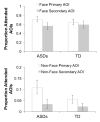Bottom-up attention orienting in young children with autism
- PMID: 23996226
- PMCID: PMC4089391
- DOI: 10.1007/s10803-013-1925-5
Bottom-up attention orienting in young children with autism
Abstract
We examined the impact of simultaneous bottom-up visual influences and meaningful social stimuli on attention orienting in young children with autism spectrum disorders (ASDs). Relative to typically-developing age and sex matched participants, children with ASDs were more influenced by bottom-up visual scene information regardless of whether social stimuli and bottom-up scene properties were congruent or competing. This initial reliance on bottom-up strategies correlated with severity of social impairment as well as receptive language impairments. These data provide support for the idea that there is enhanced reliance on bottom-up attention strategies in ASDs, and that this may have a negative impact on social and language development.
Figures







References
-
- Amso D, Johnson SP. Learning by selection: Visual search and object perception in young infants. Developmental Psychology. 2006;42(6):1236–1245. - PubMed
-
- Bayley N. Bayley scales of infant development. 3rd ed PsychCorp; San Antonio: 2005.
-
- Bertone A, Mottron L, Jelenic P, Faubert J. Enhanced and diminished visuospatial information processing in autism depends on stimulus complexity. Brain. 2005;128:2430–2441. - PubMed
-
- Brooks R, Meltzoff AN. Infant gaze following and pointing predict accelerated vocabulary growth through two years of age: A longitudinal, growth curve modeling study. Journal of Child Language. 2008;35(1):207–220. - PubMed
Publication types
MeSH terms
Grants and funding
LinkOut - more resources
Full Text Sources
Other Literature Sources

